2000 BMW 323Ci CONVERTIBLE engine
[x] Cancel search: enginePage 168 of 199
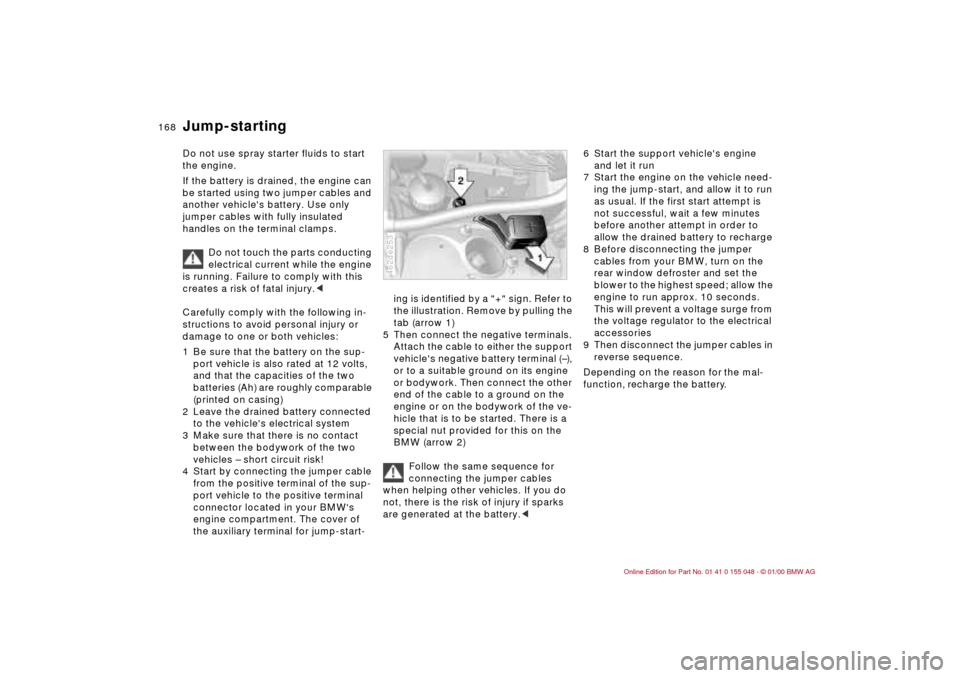
168n
Do not use spray starter fluids to start
the engine.
If the battery is drained, the engine can
be started using two jumper cables and
another vehicle's battery. Use only
jumper cables with fully insulated
handles on the terminal clamps.
Do not touch the parts conducting
electrical current while the engine
is running. Failure to comply with this
creates a risk of fatal injury.<
Carefully comply with the following in-
structions to avoid personal injury or
damage to one or both vehicles:
1 Be sure that the battery on the sup-
port vehicle is also rated at 12 volts,
and that the capacities of the two
batteries (Ah) are roughly comparable
(printed on casing)
2 Leave the drained battery connected
to the vehicle's electrical system
3 Make sure that there is no contact
between the bodywork of the two
vehicles – short circuit risk!
4 Start by connecting the jumper cable
from the positive terminal of the sup-
port vehicle to the positive terminal
connector located in your BMW's
engine compartment. The cover of
the auxiliary terminal for jump-start-
ing is identified by a "+" sign. Refer to
the illustration. Remove by pulling the
tab (arrow 1)
5 Then connect the negative terminals.
Attach the cable to either the support
vehicle's negative battery terminal (–),
or to a suitable ground on its engine
or bodywork. Then connect the other
end of the cable to a ground on the
engine or on the bodywork of the ve-
hicle that is to be started. There is a
special nut provided for this on the
BMW (arrow 2)
Follow the same sequence for
connecting the jumper cables
when helping other vehicles. If you do
not, there is the risk of injury if sparks
are generated at the battery.<462de253
6 Start the support vehicle's engine
and let it run
7 Start the engine on the vehicle need-
ing the jump-start, and allow it to run
as usual. If the first start attempt is
not successful, wait a few minutes
before another attempt in order to
allow the drained battery to recharge
8 Before disconnecting the jumper
cables from your BMW, turn on the
rear window defroster and set the
blower to the highest speed; allow the
engine to run approx. 10 seconds.
This will prevent a voltage surge from
the voltage regulator to the electrical
accessories
9 Then disconnect the jumper cables in
reverse sequence.
Depending on the reason for the mal-
function, recharge the battery.
Jump-starting
Page 172 of 199
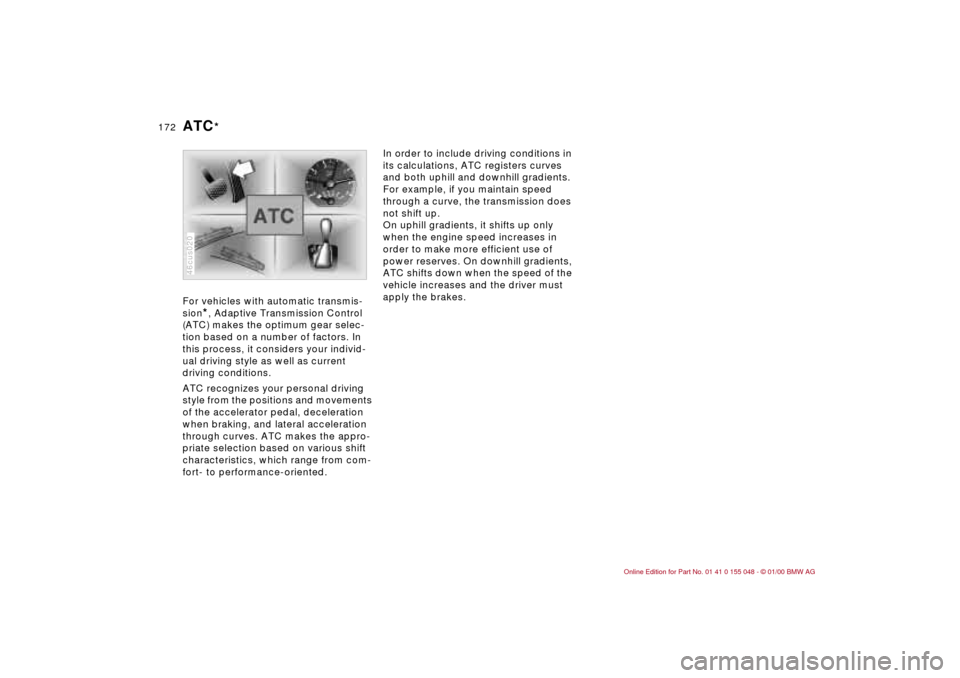
172n
For vehicles with automatic transmis-
sion
*, Adaptive Transmission Control
(ATC) makes the optimum gear selec-
tion based on a number of factors. In
this process, it considers your individ-
ual driving style as well as current
driving conditions.
ATC recognizes your personal driving
style from the positions and movements
of the accelerator pedal, deceleration
when braking, and lateral acceleration
through curves. ATC makes the appro-
priate selection based on various shift
characteristics, which range from com-
fort- to performance-oriented.
46cus020
In order to include driving conditions in
its calculations, ATC registers curves
and both uphill and downhill gradients.
For example, if you maintain speed
through a curve, the transmission does
not shift up.
On uphill gradients, it shifts up only
when the engine speed increases in
order to make more efficient use of
power reserves. On downhill gradients,
ATC shifts down when the speed of the
vehicle increases and the driver must
apply the brakes.
ATC
*
Page 173 of 199

173n
IndexDataTechnologyRepairsCar careControlsOverview
Deceleration sensors continuously
monitor the acceleration forces acting
upon the vehicle. If, as the result of a
frontal collision, a deceleration is
reached at which the protection of the
safety belts alone is no longer ade-
quate, the gas generators of the driver
and passenger-front airbags are ignited.
However, the passenger-side airbag is
only triggered if an additional sensor
has recognized that the passenger seat
is occupied.
In the event of a side collision, the
side airbags in the front are triggered
if necessary. 390de012
The airbags located under the marked
covers inflate and unfold in a matter of
a few milliseconds. In this process, they
tear through the designed separation
points of the upholstered covers or
press them out.
Because the inflation process must be
virtually instantaneous, it is necessarily
accompanied by a certain amount of
ignition and inflation noise. The gas
required to inflate the airbags is not
dangerous, and the smoke associated
with it dissipates.
The entire process is completed within
fractions of a second.Highly sensitive sensors monitor the
wheel speeds, steering angle, lateral
acceleration, brake pressure and the
movement of the vehicle around its
vertical axis.
If differences in the wheel speeds occur,
the system counteracts the danger of
wheelspin by reducing torque. If neces-
sary, the system also responds with
additional brake applications at the
rear wheels.
In addition, DSC permanently monitors
the vehicle's current operating condition
and compares it with an ideal condition
that is calculated from the sensor sig-
nals. If deviations from this occur (un-
dersteering or oversteering, for in-
stance), DSC can stabilize the vehicle in
fractions of a second by reducing engine
output and with the assistance of brak-
ing intervention at individual wheels.
As a result, most skids can be preven-
ted from their very onset.
You may need some time to become
accustomed to this system intervention.
However, it provides optimum drive
force and vehicle stability.
The braking intervention may be
accompanied by sounds specific to
the system.
Airbags DSC
Page 178 of 199
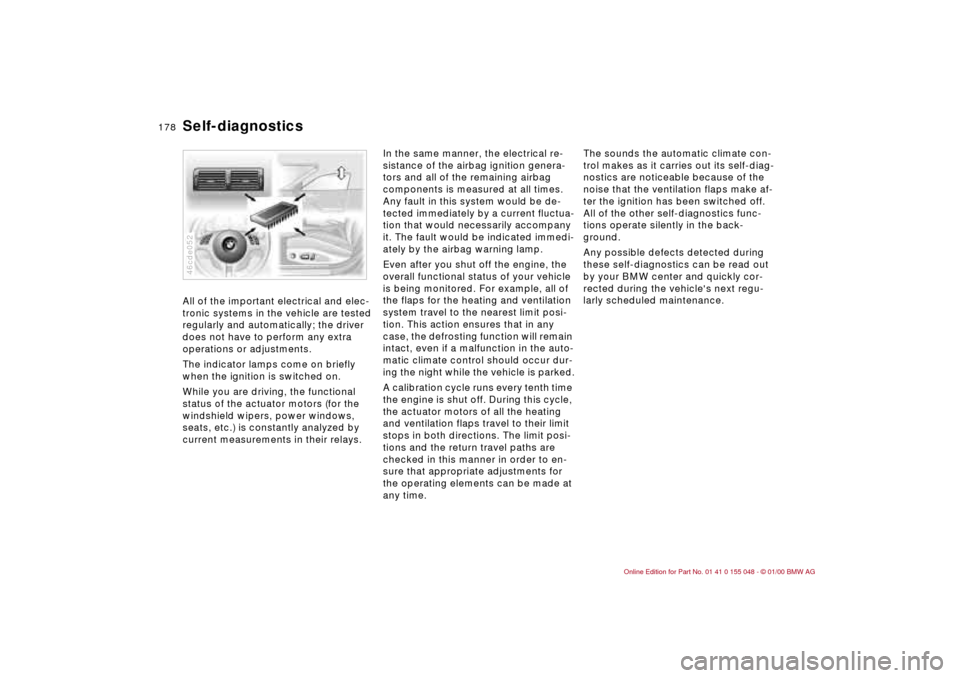
178n
Self-diagnostics All of the important electrical and elec-
tronic systems in the vehicle are tested
regularly and automatically; the driver
does not have to perform any extra
operations or adjustments.
The indicator lamps come on briefly
when the ignition is switched on.
While you are driving, the functional
status of the actuator motors (for the
windshield wipers, power windows,
seats, etc.) is constantly analyzed by
current measurements in their relays. 46cde052
In the same manner, the electrical re-
sistance of the airbag ignition genera-
tors and all of the remaining airbag
components is measured at all times.
Any fault in this system would be de-
tected immediately by a current fluctua-
tion that would necessarily accompany
it. The fault would be indicated immedi-
ately by the airbag warning lamp.
Even after you shut off the engine, the
overall functional status of your vehicle
is being monitored. For example, all of
the flaps for the heating and ventilation
system travel to the nearest limit posi-
tion. This action ensures that in any
case, the defrosting function will remain
intact, even if a malfunction in the auto-
matic climate control should occur dur-
ing the night while the vehicle is parked.
A calibration cycle runs every tenth time
the engine is shut off. During this cycle,
the actuator motors of all the heating
and ventilation flaps travel to their limit
stops in both directions. The limit posi-
tions and the return travel paths are
checked in this manner in order to en-
sure that appropriate adjustments for
the operating elements can be made at
any time.The sounds the automatic climate con-
trol makes as it carries out its self-diag-
nostics are noticeable because of the
noise that the ventilation flaps make af-
ter the ignition has been switched off.
All of the other self-diagnostics func-
tions operate silently in the back-
ground.
Any possible defects detected during
these self-diagnostics can be read out
by your BMW center and quickly cor-
rected during the vehicle's next regu-
larly scheduled maintenance.
Page 181 of 199
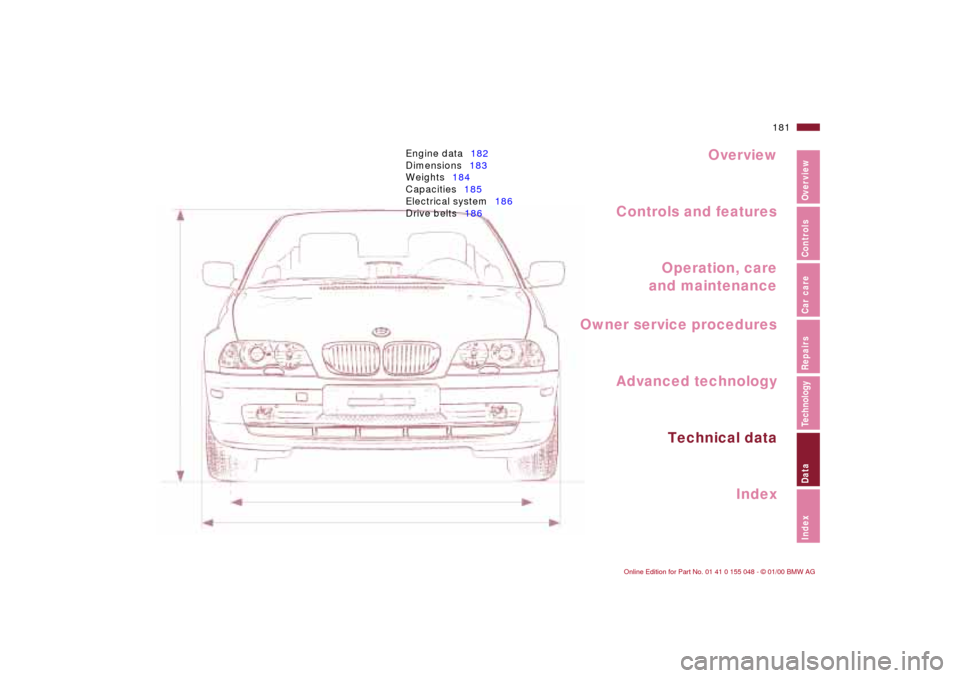
Overview
Controls and features
Operation, care
and maintenance
Technical data
Index Advanced technology
181n
IndexDataTechnologyRepairsCar careControlsOverview
Engine data182
Dimensions183
Weights184
Capacities185
Electrical system186
Drive belts186
Data
Owner service procedures
Page 182 of 199

182n
BMW 323Ci
Displacement
Number of cylinderscu. in. (cmm) 152.2 (2,494)
6
Maximum output
at engine speedhp (kW)
rpm170 (127)
5,500
Maximum torque
at engine speedlb.ft (Nm)
rpm181 (245)
3,500
Compression ratioe
10.5
Stroke
Borein (mm)
in (mm)2.95 (75)
3.31 (84)
Fuel-injection system Digital electronic engine-management system
Engine data
Page 185 of 199

185n
IndexDataTechnologyRepairsCar careControlsOverview
Capacities
Notes
Fuel tank
reserve gal. (liters)
gal. (liters)approx. 16.6 (approx. 63)
approx. 2.1 (approx. 8)Fuel specification: page 27
Windshield washer system/
Headlamp washer system
*
quarts (liters) approx. 5.6 (approx. 5.3)For details: page 132
Cooling system including heater circuit quarts (liters) approx. 8.9 (approx. 8.4) For details: page 135
Engine oil filter change quarts (liters) approx. 6.9 (approx. 6.5) BMW High Performance
Synthetic Oil
For further information, refer to
page 134
Manual and automatic
* transmission and
differential– Lifetime fluid, no fluid change
required
Page 190 of 199
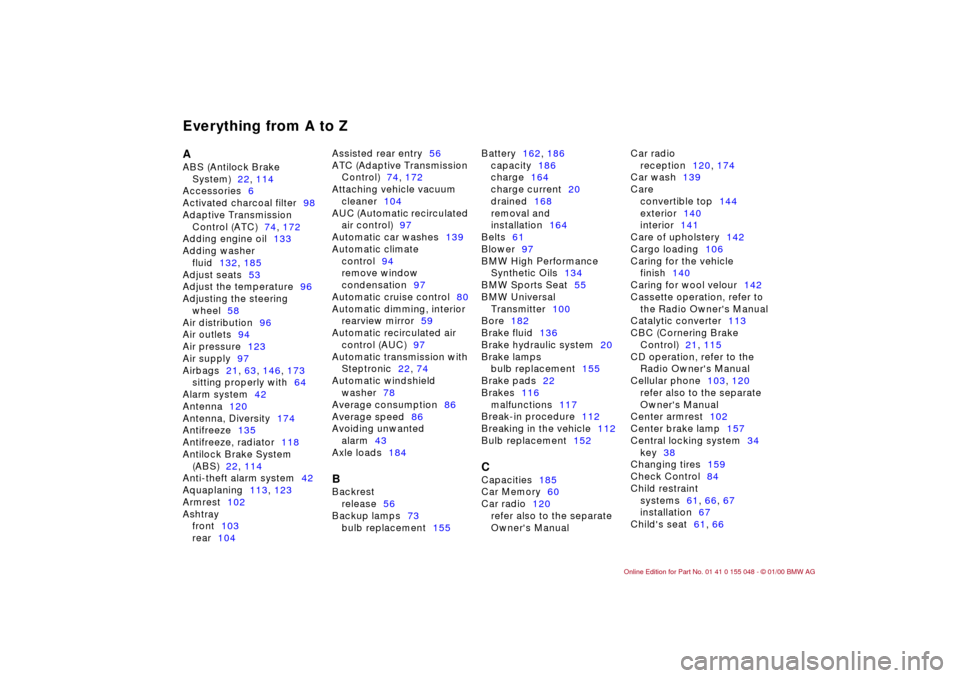
Everything from A to ZAABS (Antilock Brake
System)22, 114
Accessories6
Activated charcoal filter98
Adaptive Transmission
Control (ATC)74, 172
Adding engine oil133
Adding washer
fluid132, 185
Adjust seats53
Adjust the temperature96
Adjusting the steering
wheel58
Air distribution96
Air outlets94
Air pressure123
Air supply97
Airbags21, 63, 146, 173
sitting properly with64
Alarm system42
Antenna120
Antenna, Diversity174
Antifreeze135
Antifreeze, radiator118
Antilock Brake System
(ABS)22, 114
Anti-theft alarm system42
Aquaplaning113, 123
Armrest102
Ashtray
front103
rear104Assisted rear entry56
ATC (Adaptive Transmission
Control)74, 172
Attaching vehicle vacuum
cleaner104
AUC (Automatic recirculated
air control)97
Automatic car washes139
Automatic climate
control94
remove window
condensation97
Automatic cruise control80
Automatic dimming, interior
rearview mirror59
Automatic recirculated air
control (AUC)97
Automatic transmission with
Steptronic22, 74
Automatic windshield
washer78
Average consumption86
Average speed86
Avoiding unwanted
alarm43
Axle loads184
BBackrest
release56
Backup lamps73
bulb replacement155Battery162, 186
capacity186
charge164
charge current20
drained168
removal and
installation164
Belts61
Blower97
BMW High Performance
Synthetic Oils134
BMW Sports Seat55
BMW Universal
Transmitter100
Bore182
Brake fluid136
Brake hydraulic system20
Brake lamps
bulb replacement155
Brake pads22
Brakes116
malfunctions117
Break-in procedure112
Breaking in the vehicle112
Bulb replacement152
CCapacities185
Car Memory60
Car radio120
refer also to the separate
Owner's ManualCar radio
reception120, 174
Car wash139
Care
convertible top144
exterior140
interior141
Care of upholstery142
Cargo loading106
Caring for the vehicle
finish140
Caring for wool velour142
Cassette operation, refer to
the Radio Owner's Manual
Catalytic converter113
CBC (Cornering Brake
Control)21, 115
CD operation, refer to the
Radio Owner's Manual
Cellular phone103, 120
refer also to the separate
Owner's Manual
Center armrest102
Center brake lamp157
Central locking system34
key38
Changing tires159
Check Control84
Child restraint
systems61, 66, 67
installation67
Child's seat61, 66
Everything from A to Z